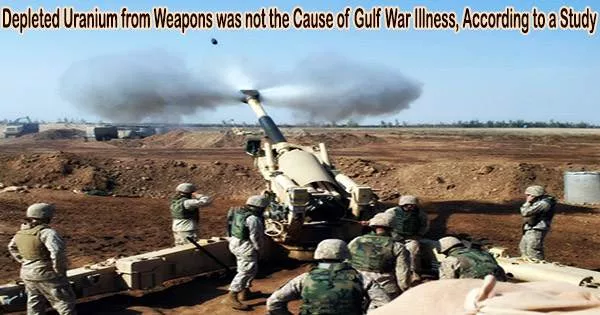Gulf War illness (GWI) was not caused by inhaling depleted uranium from exploding weapons in veterans serving in the 1991 Persian Gulf War, according to a recent study co-authored by a renowned expert on the ailment at UT Southwestern. The results, which were reported today in Scientific Reports, contribute to the elimination of a long-suspected GWI cause that has sparked worry on a global scale for the past three decades.
Using high-precision multicollector mass spectrometry for the first time in such a study, Robert Haley, M.D., director of the division of epidemiology at UTSW, and Randall Parrish, Ph.D., professor of isotope geology at the University of Portsmouth in England, collaborated to examine a representative sampling of veterans’ urine maintained by UT Southwestern’s Gulf War Illness Research program. Their study observed no differences between control veterans without GWI and those who met the standard-case definitions of GWI in the secretion of uranium isotopic ratios.
“Randy Parrish is a world expert in measuring uranium isotopes, and he had already been consulting in the U.K. for their Gulf War illness studies,” says Haley, a professor of internal medicine who has been investigating GWI for 27 years and holds the U.S. Armed Forces Veterans Distinguished Chair for Medical Research, Honoring Robert Haley, M.D., and America’s Gulf War Veterans.
“That depleted uranium is not and never was in the bodies of those who are ill at sufficient quantities to cause disease will surprise many, including sufferers who have, for 30 years, suspected depleted uranium may have contributed to their illness,” says Parrish.
GWI is a chronic illness with symptoms that may include fatigue, fever, night sweats, memory and concentration issues, diarrhea, sexual dysfunction, and chronic body pain. It affects about 25% of the roughly 700,000 U.S. and coalition military personnel deployed in the theater of operations for the Persian Gulf War.
The symptoms are comparable to disorders of the autonomic nervous system and cholinergic system of the brain, which is connected to cognitive processes like memory, selective attention, and emotional processing.
These findings essentially rule out a role for DU in causing GWI. They also have implications for the international debate over whether DU has since been causing illness in other war theaters where DU munitions were used, since the concern for those situations was originally raised by speculation that depleted uranium caused GWI.
Robert Haley
Since 1998, the National Academy of Medicine has released numerous Department of Veterans Affairs-supported reports on possible causes of GWI. The extensive list of potential causes over the years has included the physical and psychological strain of war, pesticide or nerve gas exposure, depleted uranium (DU) munition exposures, pyridostigmine bromide pills taken by troops to protect against nerve agents, vaccinations for in-theater infections and toxins, and exposure to downwind oil and smoke that was emitted for months from the Gulf War’s oil platforms.
The U.S. military has used depleted uranium since the 1990s for tank armor and some munitions due to its high density that allows for it to penetrate enemy armored vehicles. DU is created when natural uranium from the earth’s crust is “enriched” to create uranium that can be used in nuclear reactors by removing higher-energy uranium isotopes. The remaining uranium still has the same chemical toxicity as naturally occurring uranium despite having had around 40% of its radioactivity decreased.
Small DU particles that can be eaten or inhaled, as well as bigger DU shrapnel shards that can lodge themselves in muscle and soft tissue, are both released during the powerful explosion caused when a DU bullet penetrates a vehicle. Heavy metal poisoning and alpha particle radiation from DU concentration in the affected people’s lungs, kidneys, and bones are thought to cause later harmful effects.
During the Gulf War, about 300 tons of DU munitions were fired at targets in Kuwait and southern Iraq, resulting in some friendly-fire incidents as well as secondary aerosol exposures.
The Department of Veterans Affairs currently reports that some veterans of the Gulf War, Bosnia, Operation Enduring Freedom, Operation Iraqi Freedom, and Operation New Dawn may have been exposed to DU when they were in or around vehicles hit with friendly fire; near burning vehicles; close to fires involving DU munitions; or around damaged vehicles being salvaged.
Haley and Parrish undertook the study after realizing that the role of DU in GWI had never been adequately tested. Using methods developed by the British Royal Society, they calculated the level of DU to be found in urine over time after varying illness-causing levels of exposure.
While adequate for detecting DU in the few veterans with large fragments of retained shrapnel, they discovered that the less sensitive sector-field mass spectrometry used to measure DU in urine in earlier studies would not detect the smaller amounts expected from the much more typical inhalation exposure or oral ingestion.
The type of multicollector mass spectrometer operated by Parrish, which gave results at least 10 times more sensitive and robust than the measurements employed in previous GWI studies, could detect the lower levels expected.
In their study Parrish tested for the lower levels of DU in 154 urine samples, including 106 taken from veterans with GWI meeting standard-case definitions and the rest comprising two control groups representing Gulf War veterans without GWI symptoms and veterans who were not deployed.
The participants, who were selected from a national sample of Gulf War veterans, participated in the study in a hospital research unit. Urine was collected for 24 hours in special collection bottles that had been prewashed with nitric acid to get rid of any traces of natural uranium that might have interfered with the DU assay.
In all samples, the scientific partners found no DU present not in any of those with the illness, not in the control group deployed in theater, nor in those who weren’t on the battlefield, not even in the sample from a U.S. Army officer who survived a friendly-fire incident that destroyed his Bradley Fighting Vehicle, causing him to inhale the resulting hot DU-containing gases and peppering him with shrapnel that was removed months later.
Given the high sensitivity of the DU assay, the representativeness of the veterans in the study and their typical patterns of GWI, the study would have found DU at the expected levels in the GWI veterans but not in the controls, if DU was the cause of GWI. Finding none for the first time strongly rejects the link.
“These findings essentially rule out a role for DU in causing GWI,” Haley says. “They also have implications for the international debate over whether DU has since been causing illness in other war theaters where DU munitions were used, since the concern for those situations was originally raised by speculation that depleted uranium caused GWI.”
Parrish adds, “This question of the link between depleted uranium and the illness has bubbled along now for nearly 30 years, but we would argue it’s time to look elsewhere. Disproving the suspected connection between this radioactive substance and GWI allows the medical community to focus more clearly on what the likely cause(s) actually are.”
The most likely remaining causes of GWI, according to the investigators, are widespread low-level exposure to sarin nerve gas brought on by the destruction of Iraqi chemical weapons storage facilities in January 1991, which may have been exacerbated by coalition forces’ use of anti-nerve agent drugs and pesticides to prevent insect-borne illnesses.
















